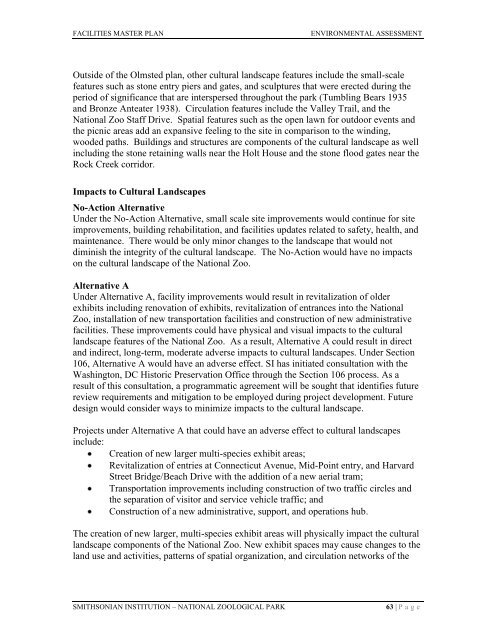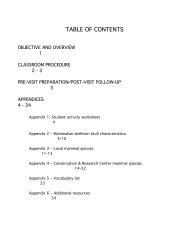facilities renewal master plan - National Zoo - Smithsonian Institution
facilities renewal master plan - National Zoo - Smithsonian Institution
facilities renewal master plan - National Zoo - Smithsonian Institution
You also want an ePaper? Increase the reach of your titles
YUMPU automatically turns print PDFs into web optimized ePapers that Google loves.
FACILITIES MASTER PLAN ENVIRONMENTAL ASSESSMENT<br />
Outside of the Olmsted <strong>plan</strong>, other cultural landscape features include the small-scale<br />
features such as stone entry piers and gates, and sculptures that were erected during the<br />
period of significance that are interspersed throughout the park (Tumbling Bears 1935<br />
and Bronze Anteater 1938). Circulation features include the Valley Trail, and the<br />
<strong>National</strong> <strong>Zoo</strong> Staff Drive. Spatial features such as the open lawn for outdoor events and<br />
the picnic areas add an expansive feeling to the site in comparison to the winding,<br />
wooded paths. Buildings and structures are components of the cultural landscape as well<br />
including the stone retaining walls near the Holt House and the stone flood gates near the<br />
Rock Creek corridor.<br />
Impacts to Cultural Landscapes<br />
No-Action Alternative<br />
Under the No-Action Alternative, small scale site improvements would continue for site<br />
improvements, building rehabilitation, and <strong>facilities</strong> updates related to safety, health, and<br />
maintenance. There would be only minor changes to the landscape that would not<br />
diminish the integrity of the cultural landscape. The No-Action would have no impacts<br />
on the cultural landscape of the <strong>National</strong> <strong>Zoo</strong>.<br />
Alternative A<br />
Under Alternative A, facility improvements would result in revitalization of older<br />
exhibits including renovation of exhibits, revitalization of entrances into the <strong>National</strong><br />
<strong>Zoo</strong>, installation of new transportation <strong>facilities</strong> and construction of new administrative<br />
<strong>facilities</strong>. These improvements could have physical and visual impacts to the cultural<br />
landscape features of the <strong>National</strong> <strong>Zoo</strong>. As a result, Alternative A could result in direct<br />
and indirect, long-term, moderate adverse impacts to cultural landscapes. Under Section<br />
106, Alternative A would have an adverse effect. SI has initiated consultation with the<br />
Washington, DC Historic Preservation Office through the Section 106 process. As a<br />
result of this consultation, a programmatic agreement will be sought that identifies future<br />
review requirements and mitigation to be employed during project development. Future<br />
design would consider ways to minimize impacts to the cultural landscape.<br />
Projects under Alternative A that could have an adverse effect to cultural landscapes<br />
include:<br />
Creation of new larger multi-species exhibit areas;<br />
Revitalization of entries at Connecticut Avenue, Mid-Point entry, and Harvard<br />
Street Bridge/Beach Drive with the addition of a new aerial tram;<br />
Transportation improvements including construction of two traffic circles and<br />
the separation of visitor and service vehicle traffic; and<br />
Construction of a new administrative, support, and operations hub.<br />
The creation of new larger, multi-species exhibit areas will physically impact the cultural<br />
landscape components of the <strong>National</strong> <strong>Zoo</strong>. New exhibit spaces may cause changes to the<br />
land use and activities, patterns of spatial organization, and circulation networks of the<br />
SMITHSONIAN INSTITUTION – NATIONAL ZOOLOGICAL PARK 63 | P a g e

















